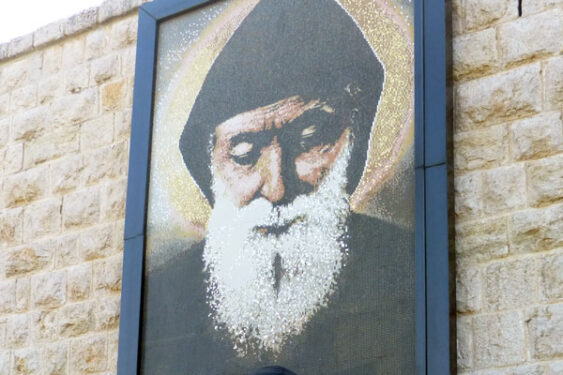
By Alexandra Moyen
ROSEDALE — After a deadly blast in Beirut, Lebanon injured more than 5,000 and killed roughly 135, Christian Lebanese are likely to turn to St. Charbel for his miraculous healing.
In a country where 60 percent of the population is Muslim and nearly thirty-five percent are Christian, most of whom are Maronite Catholics, St. Charbel is a powerful saint to pray to. The Shrine of St. Charbel in Annaya receives roughly four million visitors a year. Here, lies the remains of the renowned priest-monk and his artifacts and relics. Pilgrims can also visit a monastery within the shrine where the saint was known to live and work for roughly 20 years. Since 1950, when the monastery began to formally record miraculous healings, they have archived over 29,000 miracles.
The miraculous Lebanese saint, revered by Christians and Muslims alike, was born Youssef Antoun Makhlouf on May 8, 1828, in Bekaa Kafra, North Lebanon where he was also baptized as a Catholic Maronite. Attracted from a young age to hermit life and saints became his first-year novitiate at Our Lady of Mayfouk Monastery in Mount Lebanon in 1851. After being ordained a priest in 1859, St. Charbel became a hermit in 1875 and entered the Hermitage of St. Peter and St. Paul in Annaya, Mount Lebanon where he died on December 24, 1898. The next day, he was buried at St. Maroun’s Monastery but his tomb was opened due to a bright and dazzling light coming out of the tomb. When opened on April 15, 1899, St. Charbel’s body was found to be intact and to be exuding blood-like moisture for the next 67 years.
Since his body has been buried, pilgrims have been visiting his gravesite and in 1977 the monastery received roughly 135,000 letters from 95 countries around the world describing their miracles. On October 9, 1977, St. Charbel became a saint and thousands gathered in Ayanna, Lebanon to honor Lebanon’s first saint. Many witnesses said they had seen the statue of St. Charbel bless the crowd by granting several paralytics the ability to walk again and a blind girl her vision.
One of the miracles recorded by the monastery was that of a 45-year-old Italian woman who suffered from a neurological disease. After she discovered it, she was hospitalized for trying to commit suicide by drinking acid. The damage to her esophagus and intestines was beyond repair according to her doctor causing her parents to look for divine intervention. The woman’s parents began praying and invited others to join. A religious sister of the Maronite rite heard of this and sent the parents holy oil from St. Charbel. Once they spread the oil on their daughter’s stomach, chest, and head she was cured.
Two cures considered miracles by the Catholic Church were the healings of Sister Maria Abel Kamari who suffered from an ulcer, and Alessandro Obeid who was blind in his right eye after an accident. These cures were instrumental to his beatification on December 5, 1965, and the reason for his canonization.
Although Lebanon took early measures to prevent the spread of the coronavirus, many Lebanese have also turned to the saint for healing from the virus.
A Lebanese woman claimed she had a vision from St. Charbel telling her to collect soil from his gravesite, boil it in water, and filter it to put it into individual bottles to bring to Rafik Hariri University Hospital. On March 4, she went to the hospital but was turned away. However, sick Christians within the hospital heard of her visit and wanted the bottles. A few days later, although the hospital didn’t encourage it, the bottles were given to patients who requested it. Of the six who requested it, four survived, according to the hospital.
In a Second Vatican Council meeting on December 5, 1965, St. Paul VI said in a speech that St. Charbel is one “who reminds us of the indispensable role of prayer, hidden virtues, and penance.” He said St. Charbel’s beatification is a “truly a great day” for the Maronite Order and Lebanese Catholics.
In an excerpt from his 1965 speech on his beatification, St. Paul VI said:
“May Blessed Charbel lead us in his footsteps on the paths of holiness in which silent life in the presence of God has its place. May he make us understand, in a world too often fascinated by wealth and comfort, the irreplaceable value of poverty, penance, asceticism, to free the soul in its ascent to God. Certainly, the practice of these virtues is diverse according to the state of life and the responsibilities of each one, but no Christian can do without them if he wants to follow our Lord. These are the high lessons that Charbel Makhlouf gives us so opportunely. So that they are understood and put into practice, We call on all, through the intercession of this new Blessed already so venerated, a broad outpouring of graces and We paternally bless you.”

Saint Charbel – Pray for us.
Pray for us, Pelagie, Anne Mary Caroline, Christine, Victoria Marie, Julia Ann and me Hany.
St. Charbel whisper into Jesus’ ear our humble requests !